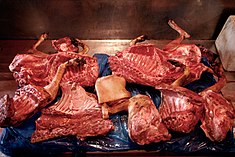
Back لحم الكلب Arabic কুকুৰৰ মাংস Assamese Karneng ayam BCL Кучешко месо Bulgarian কুকুরের মাংস Bengali/Bangla Psí maso Czech Hundefleisch German Hundoviando Esperanto Carne de perro Spanish گوشت سگ Persian
 Various cuts of dog meat for sale at a market in South Korea | |||||||||||||||||||||||||||||||||
| Nutritional value per 100 g (3.5 oz) | |||||||||||||||||||||||||||||||||
|---|---|---|---|---|---|---|---|---|---|---|---|---|---|---|---|---|---|---|---|---|---|---|---|---|---|---|---|---|---|---|---|---|---|
| Energy | 1,096 kJ (262 kcal) | ||||||||||||||||||||||||||||||||
0.1 g | |||||||||||||||||||||||||||||||||
| Dietary fiber | 0 g | ||||||||||||||||||||||||||||||||
20.2 g | |||||||||||||||||||||||||||||||||
19 g | |||||||||||||||||||||||||||||||||
| |||||||||||||||||||||||||||||||||
| Other constituents | Quantity | ||||||||||||||||||||||||||||||||
| Water | 60.1 g | ||||||||||||||||||||||||||||||||
| Cholesterol | 44.4 mg | ||||||||||||||||||||||||||||||||
| Ash | 0.8 g | ||||||||||||||||||||||||||||||||
| †Percentages estimated using US recommendations for adults,[2] except for potassium, which is estimated based on expert recommendation from the National Academies.[3] Source: Yong-Geun Ann (1999)[1] | |||||||||||||||||||||||||||||||||
Dog meat, also known as fragrant meat or simply fragrant,[4][5] is the meat derived from dogs. Historically human consumption of dog meat has been recorded in many parts of the world.[6]
In the 21st century, dog meat is consumed to a limited extent in Cambodia,[7] China,[8] India,[9] Indonesia, Ghana, Laos,[10] Nigeria,[11] South Korea,[12][13] Switzerland,[14] and Vietnam.[15] In these areas, the legality of dog meat consumption varies with some nations permitting it or lacking a nationwide ban. It was estimated in 2014 that worldwide, 25 million dogs are eaten each year by humans.[16]
Some cultures view the consumption of dog meat as part of their traditional, ritualistic, or day-to-day cuisine, and other cultures consider consumption of dog meat a taboo, even where it had been consumed in the past. Opinions also vary drastically across different regions within different countries.[17][18]
- ^ Ann Yong-Geun "Dog Meat Foods in Korea" Archived 7 October 2007 at Wikiwix, Bosintang (in 100 g, raw meat), Korean Journal of Food and Nutrition 12(4) 397 – 408 (1999).
- ^ United States Food and Drug Administration (2024). "Daily Value on the Nutrition and Supplement Facts Labels". FDA. Archived from the original on 27 March 2024. Retrieved 28 March 2024.
- ^ National Academies of Sciences, Engineering, and Medicine; Health and Medicine Division; Food and Nutrition Board; Committee to Review the Dietary Reference Intakes for Sodium and Potassium (2019). "Chapter 4: Potassium: Dietary Reference Intakes for Adequacy". In Oria, Maria; Harrison, Meghan; Stallings, Virginia A. (eds.). Dietary Reference Intakes for Sodium and Potassium. The National Academies Collection: Reports funded by National Institutes of Health. Washington, DC: National Academies Press (US). pp. 120–121. doi:10.17226/25353. ISBN 978-0-309-48834-1. PMID 30844154. Retrieved 5 December 2024.
- ^ "fragrant meat". Oxford Reference. Retrieved 13 October 2024.
- ^ "fragrant meat", Wiktionary, the free dictionary, 27 September 2024, retrieved 13 October 2024
- ^ Schwabe, Calvin W. (1979). Unmentionable cuisine. University of Virginia Press. p. 168. ISBN 978-0-8139-1162-5.
- ^ "Dog-meat Business Survives Despite Opposition". Cambodianess. 25 August 2021.
- ^ Rupert Wingfield-Hayes (29 June 2002). "China's taste for the exotic". BBC News. Retrieved 15 May 2007.
- ^ PTI (5 June 2023). "HC orders quashing of ban on dog meat in Nagaland". Nagaland Tribune. Retrieved 7 September 2023.
- ^ "Dog Meat Trade a Serious Business in Vientiane". The Laotian Times. 9 September 2020.
- ^ Murray, Senan (6 March 2007). "Dog's dinners prove popular in Nigeria". BBC News. Retrieved 6 March 2006.
- ^ "알림".
- ^ Podberscek, Anthony L. (2009). "Good to Pet and Eat: The Keeping and Consuming of Dogs and in South Korea" (PDF). Journal of Social Issues. 65 (3): 622. doi:10.1111/j.1540-4560.2009.01616.x. Archived from the original (PDF) on 19 July 2011.
- ^ "Not Just for Christmas: Swiss Urged to Stop Eating Cats and Dogs". Newsweek. 26 November 2014.
Hundreds of thousands of people in Switzerland eat cat and dog meat, particularly at Christmas, according to a Swiss animal rights group seeking to ban the practice.
- ^ "Vietnam's dog meat tradition". BBC News. 31 December 2001. Retrieved 15 May 2007.
- ^ Czajkowski, Claire (2014). "Dog meat trade in South Korea: A report on the current state of the trade and efforts to eliminate it". Animal Law Review. 21: 29–64. Archived from the original on 9 January 2024. Retrieved 18 September 2024.
- ^ "Dachshunds Are Tenderer". Time. 25 November 1940. Archived from the original on 16 October 2007. Retrieved 20 January 2008.
- ^ Mawson, Douglas (1914). The Home of the Blizzard.